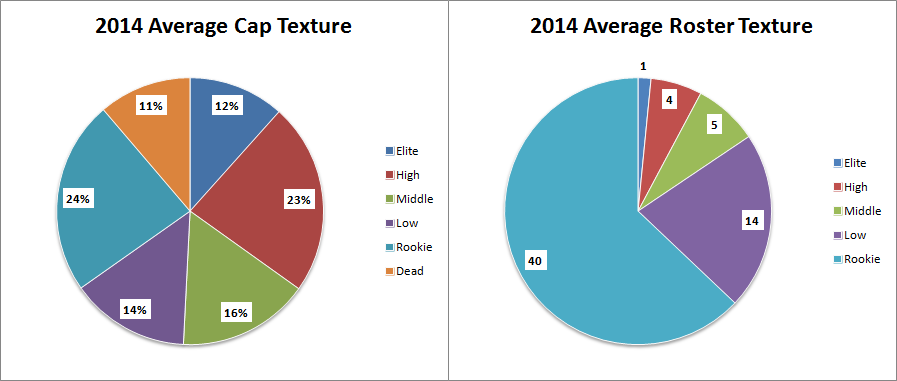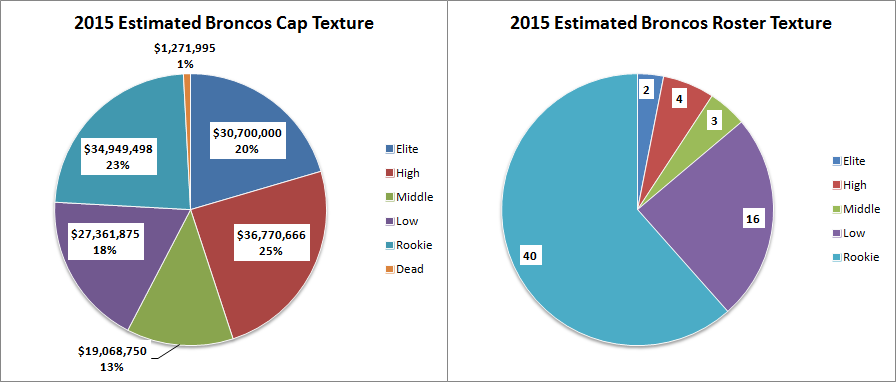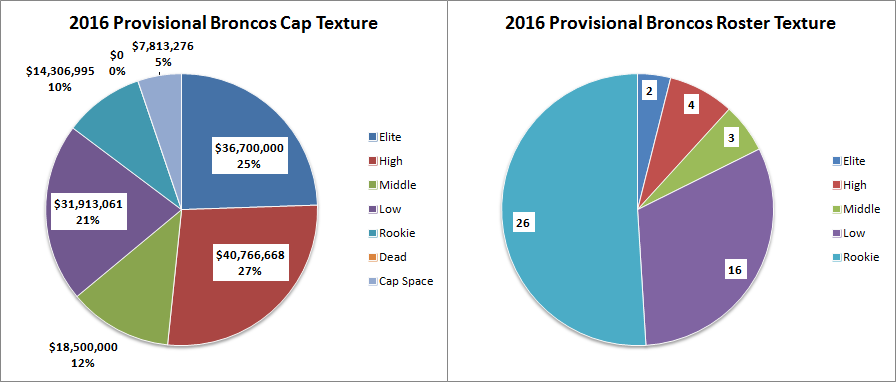The Broncos under John Elway have been quite the fun ride so far—beginning with the drafting of Von Miller and adding its latest chapter with the extension of Demaryius Thomas. But how did all of these chapters get put together? What did Elway and the Denver front office have to keep in mind to build the Broncos into their present state?
This is the question I’m hoping to explore further in a new concept I’m bringing to Over The Cap—the idea of texture when it comes to roster decisions, contract signings, and salary cap management. Some of the aspects in this texture may include:
- How many high-profile veteran signings can a team make before it runs against the cap? Who do you have to let test the free agency market?
- How much should a team rely on young players and the draft, in contrast to shopping in the veteran bargain bin?
- How much should you budget for injured players, dead money, and other unforeseen liabilities?
I’ll be looking at that for all 32 teams in due time at OTC, but since I’m more familiar with the Broncos’ roster, I’ll take this project off here for an inaugural flight.
The Six Classes Of Texture
NOTE: for purposes of this concept, “veteran” implies any player with four or more accrued seasons, usually a player entering the league in 2011 or earlier as of 2015. Also, all dollar figures are cap numbers, not necessarily cold hard cash.
- Elite Veteran: These are the players with the 32 highest veteran cap numbers in the league. Think of this as the equivalent of the highest paid player on each team—though of course, a few teams will have no elite contracts while a few others will have multiple. Also take special note that almost half of the players in the Elite category are quarterbacks. There is certainly a very high premium to retain a starting quarterback on a veteran contract.
- High Veteran: Represents the 33rd to 160th highest veteran cap numbers, based roughly on the 2nd-5th highest cap numbers per team.
- Middle Veteran: Represents the 161st to 320th highest veteran cap numbers, based roughly on the 6th-10th highest cap numbers per team.
- Low Veteran: Represents all veterans with cap numbers below the top 320.
- Rookie Contracts: Any player with less than four accrued seasons will fall into this category, unless their contract was extended before the 2014 season. Most of these players will be on drafted or UDFA deals, but several will also be on much shorter deals as they hop from one team to another trying to prove themselves. Almost all of these cap numbers would fall in the Low category if they were considered veterans
- Dead Money: Although all teams want to minimize this as much as possible, some amount of dead money is inevitable as a consequence of acquiring and releasing players. Therefore, teams must always account for some proportion of their cap to contain dead money.
For veterans, these are the ranges of cap numbers that were used to classify them into their tiers in 2014:
| Elite | 1-32 | $22,412,500 | $11,250,000 |
| High | 33-160 | $11,250,000 | $5,400,000 |
| Middle | 161-320 | $5,400,000 | $3,202,125 |
| Low | 321 and lower | $3,200,000 | $635,000 |
2014 Texture – Visual Representations
For 2014, this was the average texture – represented in two charts by cap numbers (Cap Texture) and by number of players (Roster Texture).
Note that while the six classes are fairly evenly distributed by cap numbers, in general the top ten players by salary eat up half of the cap, while rookies eat up only a quarter despite their 5/8ths majority presence.
In 2014, this is how the Broncos’ texture looked:
As you can see, the Broncos spent more than half of their 2014 cap (58%) for a total of $78 million on players in the three highest veteran tiers (Elite, High, and Middle). As a reminder, these were those players:
Elite
- Peyton Manning ($17.5M cap)
High
- DeMarcus Ware ($9.67M cap)
- Ryan Clady ($8.6M cap)
- Aqib Talib ($7.9M cap)
- Wes Welker ($7.65M cap)
- Louis Vasquez ($7.25M cap)
Middle
- Demaryius Thomas ($4.7M cap) still on his old CBA rookie contract, but considered a Veteran here
- Chris Harris ($4.187M cap) changed from a Rookie to a Veteran midseason
- Emmanuel Sanders ($4M cap)
- TJ Ward ($3.25M cap)
- [last and least…sigh] Britton Colquitt ($3.25M cap)
However, although the Broncos had the third highest cap spending on the top three tiers, they did not splurge at the expense of young talent. They employed 41 players on Rookie contracts (again, players with less than four accrued seasons)—a number that’s average across the league. in 2014, they only employed nine players that had cap numbers in the Low Veteran category. (Those players, by the way, were Terrance Knighton, Manny Ramirez, Jacob Tamme, Chris Clark, Will Montgomery, David Bruton, Mitch Unrein, Andre Caldwell, and Connor Barth.)
The Broncos’ 2014 texture can be seen as very comparable to the Green Bay Packers. They led the league on both spending ($93.4M for 70% of their total cap) and number (15) of players on Elite/High/Middle Veterans. Yet like the Broncos, they also retained a league average number of rookies at 40. The recent trends for both the Broncos and the Packers is to reward their best talent with lucrative contracts (see, on the wide receiver front, Demaryius Thomas and Randall Cobb), while still being willing to let the lower tiers of homegrown talent walk in free agency in exchange for compensatory picks. That last observation can be seen in contrast to the Baltimore Ravens, who are much more willing to collect better compensatory picks by letting more pending free agents walk.
2015 Projected Broncos Texture
Keep in mind that these numbers are estimates, as we really need to wait until the final cuts to 53 to get a better idea. But since I don’t expect many oddball cuts with the Broncos these charts should be pretty close:
So there’s a couple assumptions here. First, I took the top 64 cap numbers, representing the average number of players employed by NFL teams in 2014. Why 64 and not 53? Injuries. Ryan Clady and Jeff Heuerman’s cap numbers are included, and of course someone will have to replace them on the active roster. And as much as we don’t like it, there will likely be more IRed players come later in the year. For this reason, the number of Low veterans and Rookie contracts could be either overestimated or underestimated. Second, depending on the cuts of other teams, a few veterans could move up a tier—in particular, Aqib Talib is just barely under the projected $7 million cutoff between High and Middle.
The first thing that stands out is the ridiculously low amount of dead money the Broncos are projected to have in 2015. Although I expect that number to be higher, it won’t be by much. Even if the most likely veterans to be cut (Colquitt, Andre Caldwell, Antonio Smith) are indeed all released, it’s only going to add about $1.5 million to the total. That is outstanding contract management by Elway to ensure that cap dollars are being used for players on the team.
Second, with Thomas’s extension, the Broncos should have the exact same texture percentage in the Elite/High/Middle tiers as they did in 2014 (58%). While the Broncos moved Thomas up into the Elite tier, and added Von Miller into the High tier with his fifth year option, they completely removed Welker from the books, and see Colquitt and (amazingly) Harris move into the Low tier.
I must say that I’m very happy with this projected texture. There are always roadbumps in building a roster but to me this shows how great of a job Elway has done as GM. Now, what does the future hold?
2016 Provisional Broncos Texture
Make note that is very provisional, as it only has the 51 players currently under contract, and so the Rookie contracts in particular are misleading. But we’re going to be playing close attention to the non-Low veterans anyway.
The Broncos have the same number of Elite/High/Middle veterans, and they’re almost the same players, too—but the one huge exception is that Miller (not yet under contract for 2016) is replaced with Harris. However, the total 2016 cap liabilities of those tiers increases $96 million, 64% of the rough estimate of $150 million for that year’s cap.
What should be your big takeaway here? It’s one we should know well by now, and Bob just repeated it in point 4 here: at least one, if not multiple, of those nine veterans will not be on the Broncos in 2016. It will be needed to make room not only for Miller, but potentially Brock Osweiler and one of Malik Jackson or Derek Wolfe in the Middle range, plus any yet to be seen free agency acquisitions. If Manning retires, that likely takes care of the room in one fell swoop. If he doesn’t, both Ware and Clady may have to be cap casualties.
Finally, I’ll conclude with a darkhorse name that could be in danger come 2016: Talib. If Bradley Roby takes a big step forward in 2015, the Broncos may have to ask themselves if they want a 30 year old Talib taking up $10 million in cap space when he might become the #3 cornerback on the roster.



